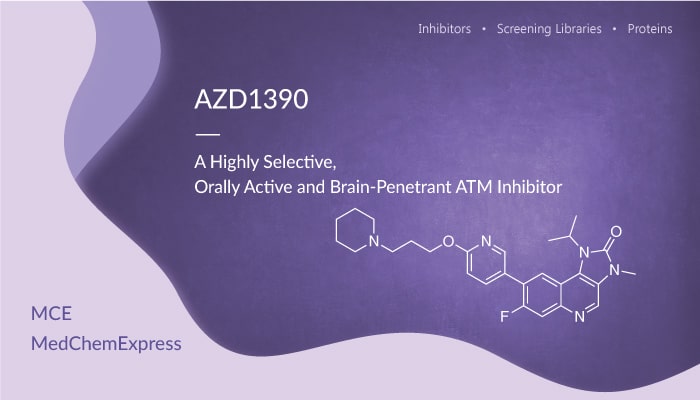Glioblastoma multiforme (GBM) is a lethal form of brain tumor arising from malignant glial cells. this disease affects 2 to 3 per 100,000 adults per year and accounts for 52% of all primary brain tumors. ATM plays a central role in the detection, signaling, and repair of DNA double-strand breaks (DSBs). Additionally, the DSBs are the most cytotoxic DNA lesion, and ionizing radiation (IR) and certain chemotherapies can induce DSBs.
Glioma stem cells display particularly increased resistance to IR treatment. And researchers show that GBM stem cells from different patients display a more robust intrinsic phospho-ATM (pATM) signal and radiation induces pATM even further.
AZD0156 is a substrate for efflux transporters. Additionally, it is therefore not likely to significantly cross the BBB.
In this article, we will introduce an orally bioavailable ATM inhibitor, AZD1390.

It is a potent, highly selective ATM inhibitor with an IC50 of 0.78 nM in cells. Besides, AZD1390 shows excellent physical and chemical properties and greatly improved BBB penetration in the mouse, rat, and monkey. AZD1390 preferentially radiosensitizes p53-deficient GBM cell lines. Recently, researchers show that this may be due, in part, to an inability of p53-deficient cells to arrest after IR-induced DNA damage. However, ATM inhibition exacerbates this by blocking the repair of DSBs and causing cell death by mitotic catastrophe.
Median survival of mice treated with AZD1390 and radiation is significantly longer than untreated control mice. No overt signs of treatment toxicity are observed with small animal radiation research platform (SARRP) contrary to whole-head irradiated mice that seem to develop mucositis and difficulties drinking and eating at doses >10 Gy in combination with AZD1390. ATM inhibitors radiosensitize human and mouse glioma cells. Additionally, it also significantly improves the survival of mice with orthotopic tumors.
In conclusion, AZD1390 is a promising ATM inhibitor and can be used for cancer research, especially brain tumors.
[1]. Durant ST, et al. Sci Adv. 2018 Jun 20;4(6):eaat1719.
[2]. J. Kahn, et al. IJROBP. 2017. 99, 600-601.